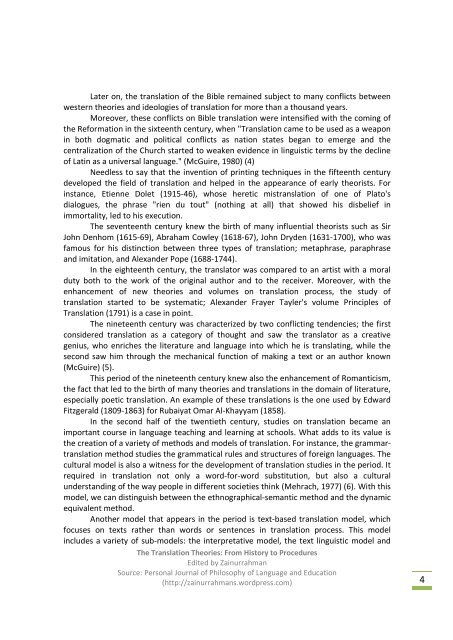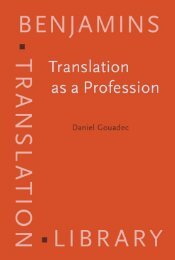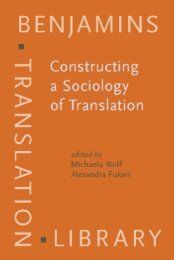Translation Theories.pdf
Translation Theories.pdf
Translation Theories.pdf
You also want an ePaper? Increase the reach of your titles
YUMPU automatically turns print PDFs into web optimized ePapers that Google loves.
Later on, the translation of the Bible remained subject to many conflicts between<br />
western theories and ideologies of translation for more than a thousand years.<br />
Moreover, these conflicts on Bible translation were intensified with the coming of<br />
the Reformation in the sixteenth century, when "<strong>Translation</strong> came to be used as a weapon<br />
in both dogmatic and political conflicts as nation states began to emerge and the<br />
centralization of the Church started to weaken evidence in linguistic terms by the decline<br />
of Latin as a universal language." (McGuire, 1980) (4)<br />
Needless to say that the invention of printing techniques in the fifteenth century<br />
developed the field of translation and helped in the appearance of early theorists. For<br />
instance, Etienne Dolet (1915-46), whose heretic mistranslation of one of Plato's<br />
dialogues, the phrase "rien du tout" (nothing at all) that showed his disbelief in<br />
immortality, led to his execution.<br />
The seventeenth century knew the birth of many influential theorists such as Sir<br />
John Denhom (1615-69), Abraham Cowley (1618-67), John Dryden (1631-1700), who was<br />
famous for his distinction between three types of translation; metaphrase, paraphrase<br />
and imitation, and Alexander Pope (1688-1744).<br />
In the eighteenth century, the translator was compared to an artist with a moral<br />
duty both to the work of the original author and to the receiver. Moreover, with the<br />
enhancement of new theories and volumes on translation process, the study of<br />
translation started to be systematic; Alexander Frayer Tayler's volume Principles of<br />
<strong>Translation</strong> (1791) is a case in point.<br />
The nineteenth century was characterized by two conflicting tendencies; the first<br />
considered translation as a category of thought and saw the translator as a creative<br />
genius, who enriches the literature and language into which he is translating, while the<br />
second saw him through the mechanical function of making a text or an author known<br />
(McGuire) (5).<br />
This period of the nineteenth century knew also the enhancement of Romanticism,<br />
the fact that led to the birth of many theories and translations in the domain of literature,<br />
especially poetic translation. An example of these translations is the one used by Edward<br />
Fitzgerald (1809-1863) for Rubaiyat Omar Al-Khayyam (1858).<br />
In the second half of the twentieth century, studies on translation became an<br />
important course in language teaching and learning at schools. What adds to its value is<br />
the creation of a variety of methods and models of translation. For instance, the grammartranslation<br />
method studies the grammatical rules and structures of foreign languages. The<br />
cultural model is also a witness for the development of translation studies in the period. It<br />
required in translation not only a word-for-word substitution, but also a cultural<br />
understanding of the way people in different societies think (Mehrach, 1977) (6). With this<br />
model, we can distinguish between the ethnographical-semantic method and the dynamic<br />
equivalent method.<br />
Another model that appears in the period is text-based translation model, which<br />
focuses on texts rather than words or sentences in translation process. This model<br />
includes a variety of sub-models: the interpretative model, the text linguistic model and<br />
The <strong>Translation</strong> <strong>Theories</strong>: From History to Procedures<br />
Edited by Zainurrahman<br />
Source: Personal Journal of Philosophy of Language and Education<br />
(http://zainurrahmans.wordpress.com) 4

















